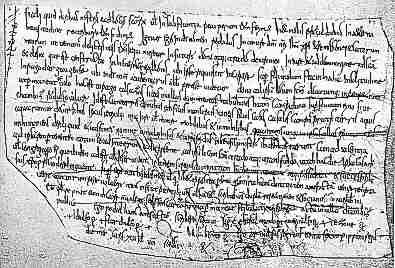
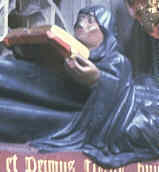
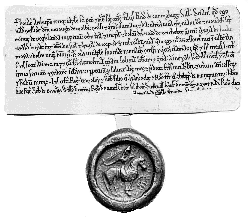
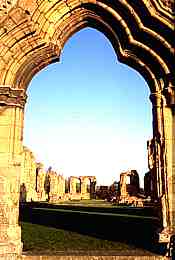
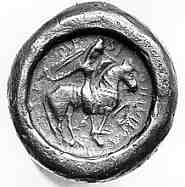
If you are looking at this page without frames, there is more information about medieval writing to be found by going to the home page (framed) or the site map (no frames).
| Private Charters | |||||
| The general format of document for the granting of privilege as used by the monarchy was adopted by private individuals. While a range of types of legal documents can be referred to as charters in a very general sense, we are referring here to the sealed, witnessed or otherwise authenticated proclamation, delivered open as a public document and conforming to a similar formula, or diplomatic, to that of the royal documents from which they were derived. | |||||
| Very few private charters survive in their original form for the early part of the middle ages, although their existence is testified by entries in the cartularies of monasteries which benefited from the grants made. The amazing library of the famous Abbey of St Gall in Switzerland preserves some early charters recording private donations to the abbey. | |||||
 |
|||||
| One of the earliest original charters from St Gall, of AD 757, in which one Podal gives various lands in Alsace, along with their appurtenances, to the abbey (St Gall, Stiftsarchiv, Urkunden I.13). (From Steffens 1929) | |||||
| The above document, written in a Merovingian minuscule script, has no seal, but follows the format of a diploma. The names of the donor and witnesses have been entered beside crosses by the scribe. It is dated Wednesday, XII kalens January in the 6th year of the reign of Pippin. | |||||
| Why would private individuals be handing over valuable real estate, and feudal services, and resources, to monastic institutions? The fundamental reason was that it was for the sake of their immortal soul. The afterlife was real, and so was purgatory. Performing good works, like giving donations to the church, could get you out of there a bit faster, especially if the monks who were the recipients of your charity said a few prayers for your immortal soul. Also, among the competitive status seekers of the upper classes, the measure of a man, and his family, was not only by what he had, but by what he could give away. But I'm sure his immortal soul took precedence over that. |
 |
||||
| The imagery of praying for the deceased is all over medieval tombs. This little canon reading the mass kneels beside the effigy of Rahere, founder of St Bartholomew's, London, on his tomb chest. | |||||
| After the Carolingian era in Europe there was a decline in the use of formal written documentation. In England before the Norman Conquest, written modes of pledge or transaction were not the norm. In these times and places witnessed oral testimony or the swearing of an oath on a ceremonial object were means of making a binding agreement. Such methods were only overtaken by written grants in the form of charters over the course of time. Religious institutions, being the heart of literate culture, sometimes had their own means of ratifying such grants with the written word. | |||||
| The fact that an oral grant had been made was sometimes noted in a blank leaf of a book, particularly a gospel, rather than in a particular form of document. | |||||
| In England the form of charter based on the Anglo-Norman writ was adopted, in similar form to royal charters, by the upper echelons of the aristocracy after the Norman Conquest. It gradually crept its way down the social scale, within the general ranks of the literate upper classes. The use of personal seals, rather than signature or notarial authentication, was also adopted down the scale. The earliest use was for the granting of privilege, especially for grants to religious institutions. | |||||
 |
 |
||||
| Charter of 1177-87 in which one Ralph Cuningburgh makes a grant of land, moor and waste adjacent to Byland Abbey to that institution (British Library, add. charter 70691). By permission of the British Library. | |||||
| Romantic image of the ruins of the Cistercian abbey of Byland in Yorkshire. | |||||
 |
The design of seal adopted by the aristocracy resembled the equestrian side of the royal great seal. The figure in armour on his horse emphasised the knightly status of the owner. This particular example seems to have a touch of Don Quixote about it, with an emaciated knight on an angular and knobby kneed horse, but I guess that is just a limitation of the seal matrix carver's art. The essential symbolism is there. | ||||
| Detail of the seal of the above document. By permission of the British Library. | |||||
| As the charter format became used by a wider range of people, it was also adapted to a diversity of purposes. The formula of conferring benefit was used in what was essentially a transaction, where the return benefit to the donor was of comparable value. The charter served as a title deed to property when both parties to the arrangement were private individuals. | |||||
|
|
|||||
|
If you are looking at this page without frames, there is more information about medieval writing to be found by going to the home page (framed) or the site map (no frames). |
|||||